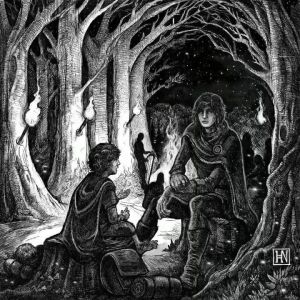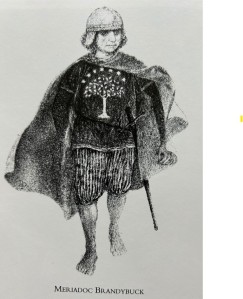 The Lenten Lord of the Rings blog has some great thoughts and themes for consideration, from the first chapters of Fellowship of the Ring, the adventures of Frodo and his friends starting in the Shire, then the taking on of the quest, and then as they travel through the Shire. In the quest motif, from its beginning through later events, it is indeed easy to see parallels to the experience of Lent (as a type of pilgrimage or journey), as well as more generally to our Christian lives as pilgrims in this world, on a journey passing through (this world is not our home) as our journey takes us through times of joy and gladness, and feasting, as well as difficulties. The themes noted at the Lenten LOTR site (see posts The Real Choice for day 2 and A Slow Start for day 3 readings) include the value of conversations and different types of conversations, festive holiday times, good people versus dangerous, evil people, mercy, the quality of good friends such as Elfs, and even the theme of mushrooms as an embodiment of home.
The Lenten Lord of the Rings blog has some great thoughts and themes for consideration, from the first chapters of Fellowship of the Ring, the adventures of Frodo and his friends starting in the Shire, then the taking on of the quest, and then as they travel through the Shire. In the quest motif, from its beginning through later events, it is indeed easy to see parallels to the experience of Lent (as a type of pilgrimage or journey), as well as more generally to our Christian lives as pilgrims in this world, on a journey passing through (this world is not our home) as our journey takes us through times of joy and gladness, and feasting, as well as difficulties. The themes noted at the Lenten LOTR site (see posts The Real Choice for day 2 and A Slow Start for day 3 readings) include the value of conversations and different types of conversations, festive holiday times, good people versus dangerous, evil people, mercy, the quality of good friends such as Elfs, and even the theme of mushrooms as an embodiment of home.
Another theme that sticks out to me, is the work of Providence, and how the hand of Iluvatar is working to bring various characters onto the scene, and often in the nick of time to avert disaster. If the evil Sauron were the only power, along with the natural course of events, Frodo with the Ring should have been caught by the Black Rider long before they reached Buckland. It is as though something restrains the Black Rider each time. The Black Rider shows up to visit Hamfast Gamgee, instead of coming next door where Frodo is. The first time along the road, Frodo almost puts on the Ring, but just then the Rider backs away. The next time, they are saved when a company of elves “just happens” to show up along the road at the same moment as a Black Rider. Obviously it works as part of a story, the sub-creation. If things occurred as they “naturally” ought to have — and as it often seems in real life, where we don’t always see the “happy coincidences” that occur in fiction — the story would have ended even before the quest had started.
Yet the same quality, of people arriving, and unexpected events, occurs in the many stories in our world’s history, and in some of the great events told in the Bible. The story of David and his band of followers, pursued by King Saul and his army, has some similarities. One time, Saul’s men are very close to capturing David, when a messenger intervenes, such that Saul and company must back off and go elsewhere. Saul is kept from harming David time and time again. Satan can only do as much harm to Job as God will allow; there is a restraint on the worker of evil. Wars among nations have gone differently due to seemingly small, unexpected events, such as the betrayal plans of Benedict Arnold falling into the hands of the American side. When Queen Esther asked for a one-day delay answer to King Ahasuerus, the next night and day of Providential events changed the outcome.
 So in our daily lives, often God brings people to us, at the “right” moment — a “chance” meeting with an acquaintance, an encouraging word at the right time when the person is depressed, information from one person is shared (in a blog post, or other online post) that answers another person’s particular situation. One person’s need for a job to be done is filled in the person with the right skills, there at the needed time. Unexpected hospitality comes, such as Frodo experiences from both the elves (and particularly Gildor) and Farmer Maggot, who are provided at the right time, companions for the situations at hand. Through all of this we marvel at the providence of Iluvatar.
So in our daily lives, often God brings people to us, at the “right” moment — a “chance” meeting with an acquaintance, an encouraging word at the right time when the person is depressed, information from one person is shared (in a blog post, or other online post) that answers another person’s particular situation. One person’s need for a job to be done is filled in the person with the right skills, there at the needed time. Unexpected hospitality comes, such as Frodo experiences from both the elves (and particularly Gildor) and Farmer Maggot, who are provided at the right time, companions for the situations at hand. Through all of this we marvel at the providence of Iluvatar.




[…] essays about J.R.R. Tolkien, from many different writers, published in 1999. My previous posts: George Sayer’s Friendship with J.R.R.…